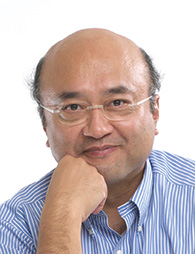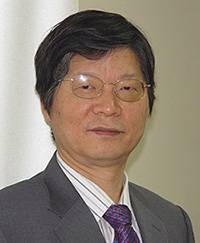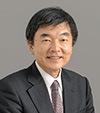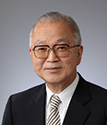2015 SID Honors and Awards
2015 SID Honors and Awards
This year’s winners of the Society for Information Display’s Honors and Awards include Junji Kido, who will receive the Karl Ferdinand Braun Prize for his outstanding contributions to the science and technology of OLEDs and pioneering contributions to commercializing white OLEDs for general lighting applications; Shohei Naemura, who will be awarded the Jan Rajchman Prize for his outstanding achievements in the chemical physics of liquid crystals and contributions to research on LCDs; Ingrid Heynderickx, who will receive the Otto Schade Prize for her outstanding contributions to the measurement, specification, and improvement of the image quality of electronic-display technologies; Jin Jang, who will be awarded the Slottow–Owaki Award for his major contributions to display education and active-matrix-display development, including AMOLED displays, AMLCDs, and flexible displays; and Allan R. Kmetz, who will receive the Lewis and Beatrice Winner Award for his exceptional and sustained service to the Society for Information Display.
by Jenny Donelan
ONCE AGAIN, the Society for Information Display honors those individuals who have made outstanding contributions to the field of displays, with awards in the category of Fellow and Special Recognition, as well as the Braun, Rajchman, Otto Schade, Slottow– Owaki, and Lewis and Beatrice Winner awards. Recipients are nominated by SID members and selected by a process involving the Honors and Awards Committee and SID’s Board of Directors. Fan Luo, chairman of the awards committee, notes that it is always difficult to select the award winners because there are so many candidates who have made major contributions to the display industry. Therefore, this year’s winners represent the best of the best.
A striking commonality among this year’s award recipients is their willingness to pass along their knowledge and enthusiasm in order to perpetuate the display industry. Four of the five awardees are professors. Junji Kido from Yamagata University not only teaches graduate students, but works with junior-high and high-school students so they can gain hands-on experience with OLED devices. Ingrid Heynderickx found that a teaching environment permitted her to gain
valuable insights from students. Jin Jang has advised 183 graduate students at Kyung Hee University, and the vast majority of these have moved on to work in the display industry not only in Korea, but all over the world. These are but three examples of how this year’s award winners are nurturing the next generation of display professionals.
Another way to grow the display industry is to become involved in the Society for Information Display, and all of this year’s winners have engaged in SID activities over the years. As a young researcher, Shohei Naemura helped promote his career by presenting at SID’s technical symposium. As he matured and became more successful, he “paid back” SID through volunteer activities. Lewis and Beatrice Winner award recipient Allan Kmetz has held numerous roles
within SID, from president to editorial advisor (he still serves in the latter capacity to this magazine). Although these activities represented work above and beyond his regular job, “I never really considered not volunteering,” says Kmetz.
This comment illustrates something else this year’s winners have in common – their willingness to take action, whether through research, teaching, or
volunteering. When asked what his advice would be to a young person looking to start a career in display research, Naemura says, “I would convey messages from two great persons out of the Western and the Eastern worlds:
What we have to learn, we learn by doing.
– Aristotle
I see and I forget. I hear and I remember. I do and I understand.
– Confucius
The 2015 winners will be honored at the SID Honors & Awards Banquet, which takes place Monday evening, June 1, 2015, during Display Week at the Fairmont Hotel in San Jose. Tickets cost $95 and must be purchased in advance – tickets will not be available on-site.
Visit www.displayweek.org for more information.
|
Karl Ferdinand Braun Prize
This award is presented for an outstanding technical achievement in, or contribution to, display technology.

Dr. Junji Kido, SID Fellow and Professor in the Department of Organic Device Engineering at Yamagata University, will receive the Karl Ferdinand Braun Prize “for his outstanding contributions to the science and technology of OLEDs and pioneering contributions to commercializing white OLEDs for general lighting applications.”
Junji Kido has spent a lifetime researching OLED technologies and applications. Among his major accomplishments are the invention of the first white-light-emitting OLED and the invention of tandem OLEDs that result in very long lifespans at high luminance levels with an internal quantum efficiency that can exceed 100%.
“In Japan,” explains Ching Tang, a Professor at the University of Rochester and the Hong Kong University of Science and Technology, “Junji Kido is not only a towering figure among OLED researchers, he is probably the best known public spokesman and the strongest advocate for everything related to OLEDs.”
Kido is the primary pioneer of the development of white OLEDs. His first white OLED used a polymer emitter layer dispersed with several kinds of fluorescent dyes. The second was fabricated with successive vacuum deposition of blue, green, and red emitter layers so that the resulting emission became white. These latter results were so notable that they were reported by major international publications. In 1995, The Wall Street Journal described his work in an article entitled “Japanese Light Researcher May Turn LED into Gold.”
Tang also points out another important aspect of Kido’s work. “It is widely acknowledged that the tandem device structure holds the key to solving the short-lifetime problem in OLED devices, which has been a major obstacle in the development of practical OLED technology. Because the tandem structure essentially allows an arbitrary number of individual OLED devices to be connected in series, a tandem OLED device can therefore produce high luminance (at a low current density) without compromising the operational stability. This invention has made possible a wide range of applications from large-area HDTVs to lighting based on OLEDs.”
Kido is also training and inspiring future generations of display and organic electronics scientists. “He is an eager educator, not only for his students at Yamagata University, but also for younger generations,” notes Toshio Suzuki, Vice-President of R&D at Kuraray America. “He invites junior-high and high school students to his laboratory to let them experience the preparation and characterization of their own OLED devices. Many students become inspired by organic electronics and some of them eventually join Kido Lab in order to further their interests.”
Kido has also founded commercial enterprises such as Lumiotec, Inc., created in 2008 as a joint venture with Mitsubishi Heavy Industry, Toppan Printing, Rohm,
and Mitsui Company to manufacture white OLED panels for lighting. He is a co-founder of Organic Lighting Corp., which manufactures OLED lighting fixtures. He is also the recipient of many prizes, including, in 2013, the Medal with Purple Ribbon from the Emperor of Japan.
Jan Rajchman Prize
This award is presented for an outstanding scientific or technical achievement in, or contribution to, research on flat-panel displays.

Dr. Shohei Naemura, SID Fellow and Guest Professor at Tottori University, will receive the Jan Rajchman Prize “for his outstanding achievements in the chemical physics of liquid crystals and contributions to research on LCDs.”
Shohei Naemura first discovered liquid crystals as a student at Kyoto University in 1968. He didn’t know what they were – they just sounded interesting to him. His initial hunch paid off. Forty-seven years later, he is still finding out interesting things about liquid crystals, and these discoveries have forwarded the industry.
Naemura’s results include the operation mechanism of liquid-crystal displays (LCDs) by focusing on the interfacial region between the liquid-crystal (LC) material and the display panel substrate, and also the relationship between the macroscopic physical properties and the chemical structures of LC materials.
His achievements in these areas were indispensable to the development of LC materials and their commercialization as well as to the research and development of modern LCDs with improved picture quality.
According to Hoi-Sing Kwok, Director of the Center for Display Research at the Hong Kong University of Science and Technology: “His research is both theoretically interesting as well as important to practical applications. This is the hallmark of a good applied physicist.”
Looking back on his research career, Naemura says: “The biggest challenge was to make organic materials (liquid-crystalline compounds) functional in electronic devices (display devices, especially active-matrix LCDs).” Going forward, he says, “[The fields of] chemistry and physics, including electronics, should work cooperatively in developing LC materials, which work together with thin-film transistors in display panels, for instance.”
Naemura notes that his involvement with SID was essential to his career. “When I started my research as a young engineer, it was my target to present a paper every year at the SID technical symposium, and thus I may say that I was developed by SID as a researcher. Later, in gratitude, I became involved in the society in order to make SID more attractive and instructive, especially for young engineers in the display science and technology field.”
To that end, he served as General Chair of IDW ’02, Chair of SID’s Japan Chapter, General Chair of Asia Display/IDW ’01, Executive Chair of IDW ’00, Program Chair of IDW ’98, and President of the Japan Chapter, as well as in numerous other roles.
Otto Schade Prize
The Otto Schade Prize is awarded for outstanding scientific or technical achievement in, or contribution to, the advancement of functional performance and/or image quality of information displays.

Dr. Ingrid Heynderickx, SID Fellow, and Dean of Industrial Engineering and Innovation Sciences at Eindhoven University of Technology, “for her outstanding contributions to the measurement, specification, and improvement of the image quality of electronic-display technologies.”
Ingrid Heynderickx has played a leading role over the last two decades in the application of psychophysics and human subjective testing to the optimization of image quality in electronic displays. In particular, she has produced pioneering work in the areas of psychophysical methods, saliency and attention measurement, eye-tracking, and large subjective rating databases. It is difficult to find an aspect of display image quality to which she has not made a contribution. She has also shepherded these research results into practical commercial advances, such as the technologies Pixel Plus, Ambilight, and LifePix at Philips Research Laboratories, a company she has been affiliated with for her entire career.
According to Scott Daly (Senior Researcher at Dolby Laboratories and previous Otto Schade winner): “Professor Heynderickx’s research career has included a wide range of topics, with results that have found significant usage by engineers in the display-industry pipeline – from capture and generation to transmission and display.”
Heynderickx’s degrees are in physics, but she discovered human factors early on in her career. Her first task at Philips Research, where she began working in 1987, was to find a solution for the poor image quality of LCDs under oblique viewing angles. She developed an electro-optical model for LCDs and used it to evaluate the performance of an LCD under different viewing angles. But she immediately realized that she needed visual-perception knowledge in order to understand which deviations from optimal performance would be visible to humans. So she visited the Institute for Perception Research (then at Eindhoven University of Technology) to find out more. It was a lightbulb moment for her. “From the first, I envied their research area,” says Heynderickx, who afterwards gradually but steadily became more involved in the applied visual perception of displays and lighting systems.
In 2005, she began teaching at both the Southeast University of Nanjing in China and at the University of Technology in Delft, The Netherlands. She eventually moved to full-time teaching in part so that she could pursue the kinds of long-term research more commonly found at universities than at private companies. She has also found it inspiring to work with students. “They force you to carefully think through and formulate your reasoning and to continuously look at your findings from a different perspective.”
Heynderickx has been an active member of SID for many years, having served as chair of the applied-vision subcommittee and also as chair of the European Program Committee. “I really learned a lot from the interaction with various committee members and regular visitors of SID. I yearly met people that I admired a lot for their expertise in the field of applied visual perception, and they were always willing to listen to my research and give advice. Especially for me, being rather isolated in this area of research here in Europe, it was great to have the opportunity to meet other members of the global visual-perception research community.”
Slottow–Owaki Prize
The Slottow–Owaki Prize is awarded for outstanding contributions to the education and training of students and professionals in the field of information displays.

Dr. Jin Jang, SID Fellow and Professor at Kyung Hee University, will receive the Slottow-Owaki Prize “for his major contributions to display education and active-matrix-display developments including AMOLED displays, AMLCDs, and flexible displays.”
To date, Jin Jang has advised the thesis and dissertation research of 183 graduate students (43 Ph.D. and 144 Master’s degrees.) Most of these graduates are now working in the display industry, with 54 at Samsung Display Co., 40 at LG Display, and others at numerous companies in Korea as well as in Japan, the U.S., the U.K, France, Taiwan, and China. “I have met many students from Jin Jang’s group,” says Heiju Uchiike, a former colleague of Jang’s at Kyung Hee University. “They are very hard working and have a wide vision of display research. In particular, the students that have graduated from his laboratory are making great contributions by developing displays in many areas of the private sector.”
At the graduate school of Kyung Hee University, where he is currently a professor, Jang established a display major in 1997 and then a Department of Information Display in 2004. The latter now accepts 60 students every year and has 12 professors.
In addition to being a prolific teacher, Jang is also known for research. Among his discoveries have been a novel technique to crystallize a-Si at low temperatures as well as well-received research on self-organized deposition, flexible displays, oxide TFTs, QLED displays, and more.
Jang says that he has been lucky enough to pursue both teaching and research because his department at the university performs practical research and creates manufacturing prototypes – the teaching is automatically combined with those activities. His advice to young students anywhere currently considering a career in displays: “Flexible displays have been a hot area recently, so job opportunities would be good for students who study oxide TFTs on plastic, LTPS TFTs on plastic, thin-film encapsulation for OLEDs, and plastic AMOLEDs.”
Jang himself started out in the display industry as a doctoral student in physics, working on TFTs and thin-film solar cells. Shortly after graduating, he collaborated with Samsung on TFT-LCD research; this experience, he says, set him solidly in the direction of display research.
Jang also became involved with SID early on, joining the organization in the late 1980s and becoming a program committee member in 1995. He has served in many other roles as well since then, including program chair of the SID symposium and general chair of Display Week and IMID. He estimates that he has attended all the SID symposia in the U.S. and all the IDW conferences in Japan for the last 20 years. “I have made many friends in Japan, Taiwan, the U.S., and Europe by attending SID-sponsored conferences,” says Jang.
Lewis & Beatrice Winner Award
The Lewis and Beatrice Winner Award for Distinguished Service is awarded to a Society member for exceptional and sustained service to SID.

Dr. Allan R. Kmetz, SID Fellow and display-industry consultant, will receive the Lewis and Beatrice Winner Award “for his exceptional and sustained service to the Society for Information Display.”
Forty years of involvement with SID began in graduate school for Lewis and Beatrice Winner recipient Allan R. Kmetz. “My thesis advisor at Yale was an officer of the IEEE Magnetics Society and he dragged me along to conferences he organized,” explains Kmetz. “After switching to displays in my first year at Texas Instruments, it just seemed natural to submit two papers to the first joint IEEE/SID conference on displays. I was a new face in a new field and the SID program committee invited me to join them. I agreed and apparently couldn’t stop.”
He has not stopped yet. Kmetz is currently on the editorial board of this magazine, having assisted for more than 10 years in helping ID to be technically (and also grammatically) accurate. He has served SID in a multitude of capacities, including lecturer and seminar organizer, program committee member, chair of the SID Technical Symposium, Honors and Awards Committee member, bylaws chair, and last but not least, president of the Society.
In this last capacity, “Allan was wonderful to work for and with,” says Jenny Bach, former SID Data Manager and previous recipient of the Lewis and Beatrice Winner Award. “As president of SID from 2002 to 2004, Allan made fantastic achievements,” says Shigeo Mikoshiba, also a past-president. “His super-clear and systematic way of thinking clarified the path to progress for SID. Academic as well as financial activities were significantly promoted through his efforts.”
Many who worked with Kmetz over the years are quick to cite his work on the organization’s bylaws. Says Past-President Munisamy Anandan: “Allan was bylaws chair during my term as president. He examined in detail the bylaws of the student branches and new chapters. He spent an enormous amount of time editing the drafts of bylaws submitted by student branches from regions where English was not the first language. Allan was also responsible for defining different categories of membership accurately in SID bylaws.”
From Kmetz’s own standpoint, one of the more rewarding aspects of his volunteer career at SID has been the annual paper-selection process with the liquid-crystal
subcommittee. “This has been one part of SID that has put me face to face with the very brightest in the field of displays,” says Kmetz. “The value I gained from this has been both professional and personal.”
Kmetz received his doctoral degree in engineering from Yale University in 1969 and went on to work for Texas Instruments, Brown Boveri Research Center in Switzerland, Bell Laboratories, and Agere Systems before retiring in 2003 to become an independent display consultant. He is the author of numerous technical papers and co-editor of the book Nonemissive Electrooptic Displays. He holds 16 U.S. and 45 foreign patents. His active display technology and intellectual-property consulting duties include aiding in portfolio evaluation and serving as an expert witness.
2015 SID Fellow Awards
The grade of Fellow is conferred annually upon SID members of outstanding qualifications and experience as scientists or engineers whose significant
contributions to the field of information display have been widely recognized.

Hidefumi Yoshida, “for his many significant contributions to LCD technology, especially wide-viewing multi-domain vertical-alignment LCDs, including protrusion geometry, photo-alignment process, halftone technology, and fast-response architecture.”
Dr. Yoshida is a Department General Manager with Sharp Corporation. He earned his Ph.D. in engineering from the Tokyo Institute of Technology.

John F. Wager, “for his pioneering contributions to the development of oxide TFTs.”
Dr. Wager is a professor and holds the Michael and Judith Gaulke Endowed Chair in the School of Electrical Engineering and Computer Science at Oregon State University. He has a Ph.D. in electrical engineering from Colorado State University.

Anne Chiang, “for her pioneering contributions to electrophoretic display technology and significant innovations in the development of polysilicon-TFT technology.”
Dr. Chiang is Principal of Chiang Consulting. She received her Ph.D. in physical chemistry from the University of Southern California.

Ryuichi Murai, “for his outstanding contributions to the research and development of PDPs, CRTs,
flat CRTs, and OLED displays and nurturing and leadership in the PDP as well as other display communities.”
Mr. Murai is a researcher with Panasonic Corporation. He has a B.S. from Osaka University.

Fujio Okumura, “for his pioneering contributions to the research and development of LTPS-TFTs
and SOG devices and significant contributions to the advancement of the display community.”
Mr. Okumura is a Senior Manager with NEC Corporation. He has an M.S. in electrical engineering from Yokohama National University.
2015 SID Special Recognition Awards
Presented to members of the technical, scientific, and business community (not necessarily SID members) for distinguished and valued contributions to the information-display field.

Jun Ho Song, “for his invention and product development in simplifying the TFT process for LCD devices and the development of 22-in. TFT-LCD TV in 1995 and integrated a-Si gate driving in TFT-LCDs in 2005.”
Dr. Song is a master researcher at Samsung Display Company. He has a Ph.D. in quantum optical physics from Korea University.

Byoungho Lee, “for his leading contributions to three-dimensional display technologies based on integral imaging and holography.”
Dr. Lee is a professor in the Electrical Engineering Department at Seoul National University. He has a Ph.D. in electrical engineering and computer science from the University of California at Berkeley.

Byeongkoo Kim, “for his leading contributions to the research and development of AH-IPS technology for high-end displays including smartphones, tablets, notebooks, monitors, and automotive displays.”
Dr. Kim is Vice-President of LG Display. He has a Ph.D. in electrical and computer engineering from Pohang University of Science and Technology.

Toshio Kamiya, “for his outstanding contribution to the material science of amorphous-oxide semiconductors.”
Dr. Kamiya is a professor and the Vice-Director of the Materials Structures Laboratory at the Tokyo Institute of Technology. He earned a Ph.D. in engineering at the Tokyo Institute of Technology.


Yasuhiro Koike and Akihiro Tagaya, “for their leading contributions to the research of zero-birefringence polymers, highly birefringent polymers, and highly scattered optical-transmission polymers and their applications in LCDs.”
Dr. Koike is a professor with the Faculty of Science and Technology at Keio University. He has a Ph.D. in engineering from Keio University.
Dr. Tagaya is a Project Professor at the Graduate School of Science and Technology, Keio University. He has a Ph.D. in engineering from Keio University.

Shunpei Yamazaki, “for discovering CAAC-IGZO semiconductors, leading their practical application, and paving the way to next-generation displays by developing new information-display devices such as foldable or 8K x 4K displays.”
Dr. Yamazaki is president of Semiconductor Energy Laboratory. He received his Ph.D. in engineering from Doshisha University.
Jenny Donelan is the Managing Editor of Information DisplayMagazine. She can be reached at jdonelan@pcm411.com.